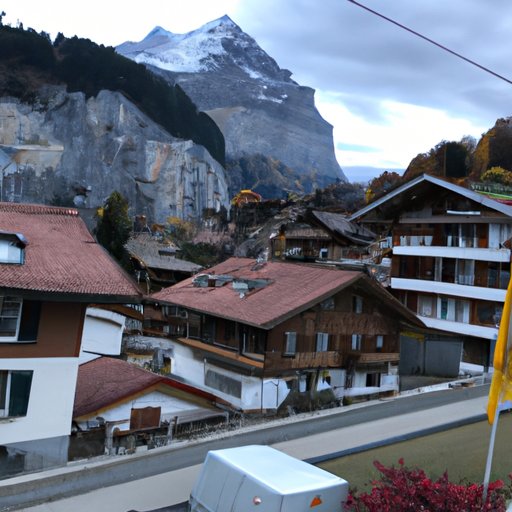I. Introduction
Switzerland is a beautiful country that draws millions of tourists every year. However, deciding on the best time to visit this country can be challenging. Each season offers a different experience, and it’s essential to consider several factors before planning your trip. In this article, we will explore the best time to visit Switzerland, the pros and cons of traveling during peak and off-season, and itinerary planning based on your interests.

II. Experience Switzerland: The Best Time to Plan Your Visit
Switzerland has four distinct seasons: spring, summer, fall, and winter. Each season has unique offerings that can make your trip unforgettable. Spring (April-May) is the time of year when Switzerland’s mountains start to come alive with greenery, wildflowers, and blooming trees. Summer (June-August) is perfect for outdoor activities such as hiking, swimming, and scenic boat rides. You’ll also find some of Switzerland’s most famous festivals, such as Basel’s Art Basel and Montreux’s Jazz Festival. Fall (September-November) offers cooler temperatures and stunning foliage, making it an ideal time for hiking and road trips. Finally, winter (December-March) is a popular time for skiing, snowboarding, and other winter sports. The Alps and other mountain regions become a winter wonderland with snowy scenery, vibrant holiday markets, and warm mulled wine.
The best time to visit Switzerland will depend on your interests and what you want to experience. If you’re looking for outdoor adventure and festivals, the summertime is your best bet. However, those looking for winter sports should plan their travel from December through March. Meanwhile, for those who enjoy fall foliage and cooler temperatures, September to November is the perfect time to visit. Spring is an excellent time for exploring Switzerland’s cities or admiring the blossoming natural scenery.

III. Switzerland Travel: The Pros and Cons of Visiting During Peak Season
Peak season in Switzerland is during the summer months of June through August and the winter months of December through March. Traveling during peak season has several advantages, such as good weather, access to popular attractions, and many outdoor activities. However, it also comes with higher prices and crowded spaces that can impact your experience.
To make the most out of your trip during peak season, be sure to book everything in advance, including flights, accommodations, and activities. This can help save you money and avoid waiting in long queues. Additionally, consider alternative activities or attractions to avoid the crowds. For example, instead of visiting popular ski resorts, look for smaller ski towns or less popular hiking trails.
IV. Escape to Switzerland: The Benefits of Traveling During the Off-Season
If crowds and high prices are a concern, traveling during the off-season should be on your radar. The off-season months are April-May and September-November. Prices for flights, accommodations, and activities are lower, and crowds are thinner. This makes it the perfect time of year for travelers looking for a budget-friendly trip or a relaxed vacation.
Switzerland offers fantastic off-season activities, such as visiting museums, exploring local towns and cities, and going on scenic drives. Be aware that some tourist destinations, restaurants, and shops in smaller towns are closed during the off-season. However, this does provide an opportunity for visitors to experience Switzerland like a local, enjoying a more authentic experience in smaller, less touristic areas.
V. Uncovering Switzerland’s Hidden Gems: Why You Should Visit in the Shoulder Season
The shoulder season is typically the period between peak and off-season. During this time, travelers can enjoy fewer crowds, mild temperatures, and still have access to many fun activities. A few of Switzerland’s lesser-known destinations and activities are especially enjoyable during the shoulder season.
Some of the hidden gems in Switzerland during this time include Luzern, Lugano, and Geneva. Luzern is famous for its historic architecture, like the Old Town, Kapellbrücke (covered bridge), and Lion Monument, which is fun to explore during the mild autumn weather. Meanwhile, Lugano is home to Italy’s influence, featuring excellent restaurants and stunning Lake Lugano. Geneva, the cosmopolitan city known for its culture and art, is a great place for concerts, museums, and a unique shopping experience.
VI. Experience Switzerland Like a Local: Choosing the Best Time to Visit for Your Itinerary
When planning your Switzerland itinerary, consider the best time to visit based on your interests. There are several options when deciding where to go and what to do, depending on the season. Beach lovers should head to Lake Geneva, while outdoor enthusiasts might prefer to trek through the Alps.
If you’re interested in food, visiting Switzerland’s cheese factories and wineries is a must-do activity. Additionally, you can plan your trip to coincide with a food festival, such as the St. Moritz Gourmet Festival in January or the Lausanne Street Food Festival in September.
VII. Conclusion
In conclusion, choosing when to visit Switzerland depends on your interests and priorities. Each season has its unique offerings, advantages, and drawbacks. Peak season comes with beautiful weather, attractions, and activities, but it also brings high prices and crowds. Meanwhile, the off-season promises lower prices, fewer crowds, and an authentic experience. Finally, the shoulder season presents several hidden gems and opportunities to explore lesser-known destinations.
Whether you’re looking for a budget-friendly trip, a relaxed vacation or seeking adventure, Switzerland has everything you need, and now you know the best time to visit. Plan your trip now, and enjoy a memorable experience in Switzerland.


